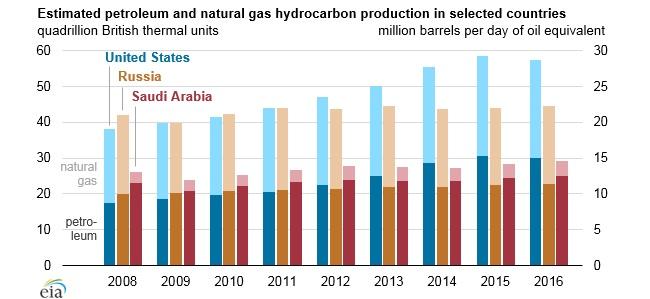
RUSSIAN OIL PRODUCTION DOWN 0.6%

PLATTS - Despite Russia being a leading member of the OPEC/non-OPEC production cut coalition, its producers face significant uncertainty as to whether participation will continue to be profitable and provide the impetus they need to keep their crude output restrained.
Lower-than-expected oil prices and a stronger-than-expected ruble, coupled with seasonal factors and a hike in drilling rates in spring, are posing a significant likelihood of output increases toward the end of the year, which could lead to a lower compliance level by Russia overall with its obligations under the production cut deal that was extended in May to the end of March 2018.
Russia achieved its target of reducing crude output by 300,000 b/d in late April, and maintained compliance at slightly above 100% in May and June, according to data from the energy ministry.
So far, the production cut has had no major impact on oil producers' financial operations as they have mainly been reducing output from less profitable wells and increasing output from more profitable reservoirs.
Due to seasonal factors, however, Russia usually produces less crude at the start of the year and gradually increases production toward the end of the year.
Therefore, questions remain as to whether oil producers will be able to fulfill their cut obligations later in the year.
Over the last 12 years, average daily output has typically risen by around 170,000 b/d from April to October, according to calculations by Sberbank CIB analysts.
The task could be complicated further by a rise in drilling operations seen this spring, after a significant drop in February, which may result in an increase in output at the end of the year.
In April, production drilling jumped by 9.8% year on year, contributing to a 6.1% increase for the first four months of the year, and drilling volumes in the next couple of months could be an indicator of the potential output dynamic later in 2017.
As of now, however, it's too early to build up production forecasts based on this data, as April was a month of "positive expectations, before oil prices dropped on the OPEC/non-OPEC decision [taken in late May to maintain output cut levels rather than reduce it further as some market players expected]," said Sberbank CIB analyst Valery Nesterov.
Nesterov estimates an increase in drilling volumes by around 5% on the year would be needed to mitigate natural decline in West Siberia and keep the output flat.
FINANCIAL DILEMMA
While Russian oil producers are not expected to face technical issues in maintaining stable output or even reducing it slightly further through a cut in drilling operations, the key question remains whether they will see that as a profitable move.
The main focus here is on those companies that have greenfield projects, which could significantly increase production in the near future, said Grigory Vygon, head of Vygon Consulting.
In the first quarter, companies benefited from efforts to support prices, but the production cuts were gradual and reached the target by the end of April.
"For the second quarter, probably, financial results could be a little bit lower because of declining oil prices, and higher production cuts," Vygon said.
In general, Russian oil companies are less impacted by oil price fluctuations than the federal budget, due to the flexibility of Russia 's tax system, under which the taxes that companies pay grow when the oil price goes up and fall when prices go down.
But oil producers' financial results are also dependent on the ruble-to-dollar exchange rate, which normally follows the price curve, compensating to some extent for losses when oil prices fall.
In this respect, the ruble-denominated cost of a barrel is more important for Russian companies than the dollar price, said Evgeniy Tolochek, president of medium-sized oil producer Russneft.
"We are not so much interested in the cost of oil but the cost of our national currency," he said.
Most recently, however, the ruble has remained overvalued, adding negative pressure to producers.
The Central Bank's policy in this respect remains unclear, many analysts have noted.
Vygon Consulting has calculated that a change of Rb1 in the ruble-to-dollar exchange rate makes a significant difference, of around Rb150 billion for the oil industry.
FLEXIBLE OIL FLOW FORECAST
The energy ministry is forecasting that crude production in Russia will fall by 0.6% year on year to 549.1 million mt, or 11.027 million b/d on average, in 2017 on the extension of the output cut deal.
There is, however, less certainty in the forecasts of export crude flows and domestic refining.
Primarily, crude processing in Russia has declined over the past couple of years, on a drastic drop in refinery margins due to recent tax changes and massive upgrades in the downstream sector, which now needs less crude to produce light oil products.
Low complexity Russian refineries saw a drastic margin drop to $1/mt (or $0.14/b) from $60/mt in 2014, analysts at VTB Capital said in a research note Wednesday.
Most high complexity refineries show better financials, but they also saw a drop in the average margin to $42/mt in 2016 from $124/mt in 2014, they estimated.
As a result, oil companies sent more crude for exports, limiting supplies to domestic refineries.
Most recently, however, there has been a reversal in this trend on record high fuel oil cracks in Europe and also a strong premium for diesel on the domestic market.
As a result, Russia 's energy ministry now expects that primary refining will remain flat year on year in 2017, compared with its May forecast, which envisaged a 1.8% cut year on year in primary refining to 280 million mt.
This is likely to impact crude oil exports flows, which had previously been expected to grow by nearly 1% year on year to 257 million mt in 2017.
-----
Earlier:





